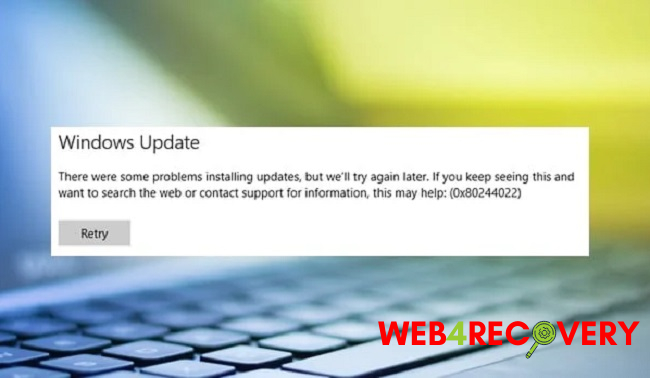Error code 0x80244022 is a common issue that Windows users encounter when attempting to install or update Windows updates.
This error can prevent the system from downloading and installing crucial updates, leaving the system vulnerable to security risks and missing out on important feature enhancements.
In this detailed article, we will explore the causes behind error code 0x80244022 for Windows updates, with a specific focus on WSUS (Windows Server Update Services) and Server 2016.
We will also provide effective solutions to help you resolve this error and successfully update your Windows system.

Understanding Error Code 0x80244022 for Windows Updates
Error code 0x80244022 is typically associated with Windows Update-related issues. When this error occurs, it indicates that the Windows Update service is unable to communicate with the update servers or download the necessary update files.
Causes of Error Code 0x80244022 for Windows Updates
Several factors can contribute to the occurrence of error code 0x80244022 for Windows updates, particularly in the context of WSUS and Server 2016:
- WSUS Configuration Issues: If you are using WSUS to manage Windows updates on your network, misconfigurations or incorrect settings within the WSUS infrastructure can lead to this error.
- Network Connectivity Problems: Network issues, such as connectivity problems or firewalls blocking the communication between the Windows Update client and the update servers, can trigger error code 0x80244022.
- Server 2016 Specific Issues: Server 2016 may encounter specific problems related to update delivery and compatibility, leading to error code 0x80244022.
Now, let’s explore the solutions to address this error.
Methods to Fix Error Code 0x80244022 for Windows Updates
1. Check WSUS Configuration
If you are using WSUS, ensure that the server is properly configured and functioning correctly:
- Verify that the WSUS server is reachable from the client machine. Ensure that the WSUS server’s URL is correct and accessible.
- Confirm that the WSUS server has the necessary updates approved for installation. Open the WSUS console and review the update approvals.
- Restart the WSUS services on the server to ensure they are running smoothly.
2. Check Network Connectivity
Network connectivity issues can disrupt communication between the client machine and the update servers. Consider the following steps:
- Check the network connection on the affected machine. Ensure that the network cable is securely connected, or if using a wireless connection, ensure a stable connection.
- Disable any firewalls or security software temporarily to check if they are blocking the Windows Update process.
- Use the Windows Network Troubleshooter to diagnose and resolve any network-related issues.
3. Clear Windows Update Cache
Clearing the Windows Update cache can help resolve issues with downloading and installing updates. Here’s how:
- Press Win + R to open the Run dialog box.
- Type
services.mscand press Enter to open the Services window. - Locate the Windows Update service.
- Right-click on Windows Update and select Stop to stop the service.
- Minimize the Services window, but keep it open for later.
- Open Windows Explorer and navigate to the following folder:
C:\Windows\SoftwareDistribution. - Delete all the contents of the SoftwareDistribution folder. You may need administrator privileges to do this.
- Return to the Services window, right-click on Windows Update, and select Start to restart the service.
4. Run Windows Update Troubleshooter
Windows provides a built-in troubleshooter tool to detect and fix common Windows Update-related issues. Here’s how to run the Windows Update Troubleshooter:
- Open the Settings menu by pressing Win + I.
- Select Update & Security.
- Click on Troubleshoot in the left-hand menu.
- Scroll down and click on Windows Update.
- Click on Run the troubleshooter and follow the on-screen instructions to complete the troubleshooting process.
5. Manually Reset Windows Update Components
If all else fails, manually resetting the Windows Update components can often resolve stubborn update-related issues. This process involves stopping the Windows Update service, renaming specific folders, and restarting the service.
However, please note that this method requires careful execution and should be followed precisely. Instructions for manually resetting Windows Update components can be found in Microsoft’s official documentation.
Conclusion
Encountering error code 0x80244022 for Windows updates can be frustrating, but with the solutions provided in this detailed guide, you should be able to resolve the issue and successfully update your Windows system.
Whether it involves checking WSUS configuration, addressing network connectivity problems, clearing the Windows Update cache, running the Windows Update Troubleshooter, or manually resetting Windows Update components, these methods should help you overcome error code 0x80244022.
Ensure that your Windows system remains up to date to benefit from enhanced security, stability, and performance.

















